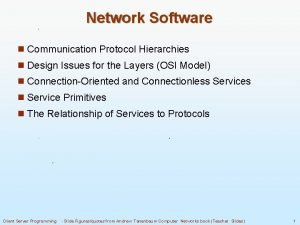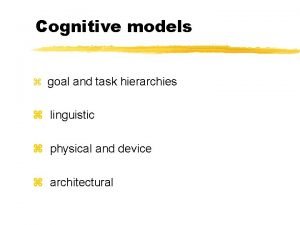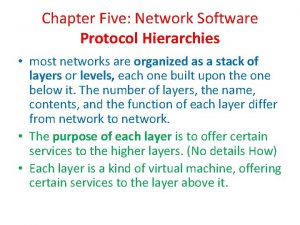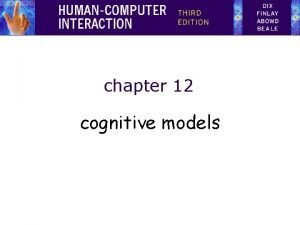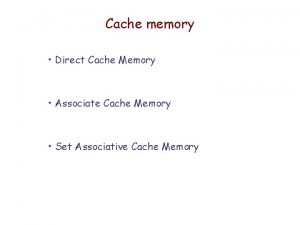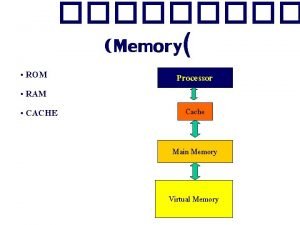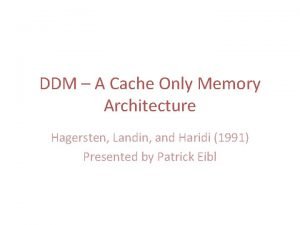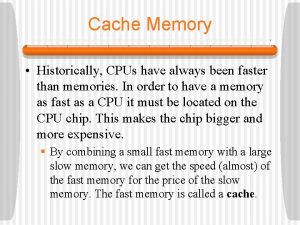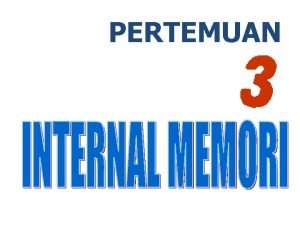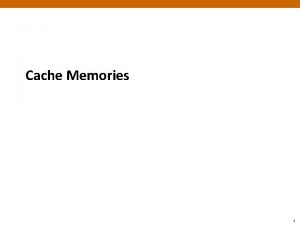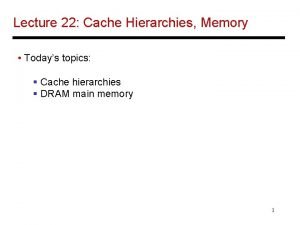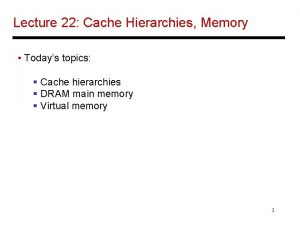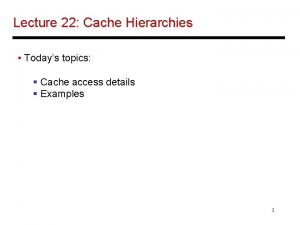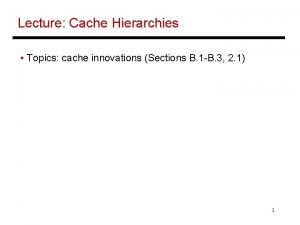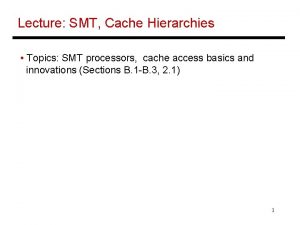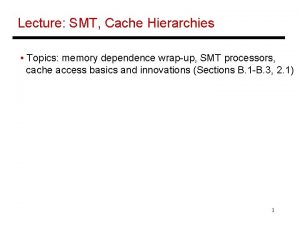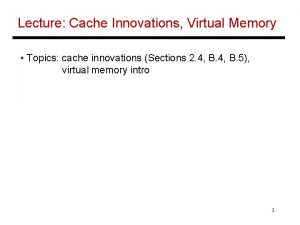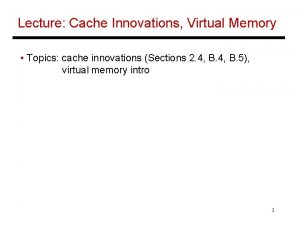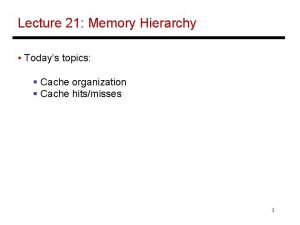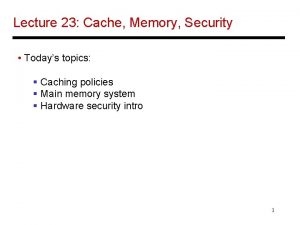Lecture 22 Cache Hierarchies Memory Todays topics Cache














- Slides: 14

Lecture 22: Cache Hierarchies, Memory • Today’s topics: § Cache hierarchies § DRAM main memory § Virtual memory 1

Cache Misses • On a write miss, you may either choose to bring the block into the cache (write-allocate) or not (write-no-allocate) • On a read miss, you always bring the block in (spatial and temporal locality) – but which block do you replace? Ø no choice for a direct-mapped cache Ø randomly pick one of the ways to replace Ø replace the way that was least-recently used (LRU) Ø FIFO replacement (round-robin) 2

Writes • When you write into a block, do you also update the copy in L 2? Ø write-through: every write to L 1 write to L 2 Ø write-back: mark the block as dirty, when the block gets replaced from L 1, write it to L 2 • Writeback coalesces multiple writes to an L 1 block into one L 2 write • Writethrough simplifies coherency protocols in a multiprocessor system as the L 2 always has a current copy of data 3

Types of Cache Misses • Compulsory misses: happens the first time a memory word is accessed – the misses for an infinite cache • Capacity misses: happens because the program touched many other words before re-touching the same word – the misses for a fully-associative cache • Conflict misses: happens because two words map to the same location in the cache – the misses generated while moving from a fully-associative to a direct-mapped cache 4

Off-Chip DRAM Main Memory • Main memory is stored in DRAM cells that have much higher storage density • DRAM cells lose their state over time – must be refreshed periodically, hence the name Dynamic • A number of DRAM chips are aggregated on a DIMM to provide high capacity – a DIMM is a module that plugs into a bus on the motherboard • DRAM access suffers from long access time and high energy overhead 5

Memory Architecture Bank Processor Row Buffer Memory Controller Address/Cmd DIMM Data • DIMM: a PCB with DRAM chips on the back and front • The memory system is itself organized into ranks and banks; each bank can process a transaction in parallel • Each bank has a row buffer that retains the last row touched in a bank (it’s like a cache in the memory system that exploits spatial locality) (row buffer hits have a lower latency than a row buffer miss) 6

Virtual Memory • Processes deal with virtual memory – they have the illusion that a very large address space is available to them • There is only a limited amount of physical memory that is shared by all processes – a process places part of its virtual memory in this physical memory and the rest is stored on disk (called swap space) • Thanks to locality, disk access is likely to be uncommon • The hardware ensures that one process cannot access the memory of a different process 7

Address Translation • The virtual and physical memory are broken up into pages 8 KB page size Virtual address virtual page number 13 page offset Translated to physical page number Physical address 8

Memory Hierarchy Properties • A virtual memory page can be placed anywhere in physical memory (fully-associative) • Replacement is usually LRU (since the miss penalty is huge, we can invest some effort to minimize misses) • A page table (indexed by virtual page number) is used for translating virtual to physical page number • The page table is itself in memory 9

TLB • Since the number of pages is very high, the page table capacity is too large to fit on chip • A translation lookaside buffer (TLB) caches the virtual to physical page number translation for recent accesses • A TLB miss requires us to access the page table, which may not even be found in the cache – two expensive memory look-ups to access one word of data! • A large page size can increase the coverage of the TLB and reduce the capacity of the page table, but also increases memory waste 10

TLB and Cache • Is the cache indexed with virtual or physical address? Ø To index with a physical address, we will have to first look up the TLB, then the cache longer access time Ø Multiple virtual addresses can map to the same physical address – must ensure that these different virtual addresses will map to the same location in cache – else, there will be two different copies of the same physical memory word • Does the tag array store virtual or physical addresses? Ø Since multiple virtual addresses can map to the same physical address, a virtual tag comparison can flag a miss even if the correct physical memory word is present 11

Cache and TLB Pipeline Virtual address Virtual page number Virtual index Offset TLB Tag array Data array Physical page number Physical tag comparion Virtually Indexed; Physically Tagged Cache 12

Bad Events • Consider the longest latency possible for a load instruction: § TLB miss: must look up page table to find translation for v. page P § Calculate the virtual memory address for the page table entry that has the translation for page P – let’s say, this is v. page Q § TLB miss for v. page Q: will require navigation of a hierarchical page table (let’s ignore this case for now and assume we have succeeded in finding the physical memory location (R) for page Q) § Access memory location R (find this either in L 1, L 2, or memory) § We now have the translation for v. page P – put this into the TLB § We now have a TLB hit and know the physical page number – this allows us to do tag comparison and check the L 1 cache for a hit § If there’s a miss in L 1, check L 2 – if that misses, check in memory § At any point, if the page table entry claims that the page is on disk, flag a page fault – the OS then copies the page from disk to memory and the hardware resumes what it was doing before the page fault … phew! 13

Title • Bullet 14
 Virtual memory and cache memory
Virtual memory and cache memory 01:640:244 lecture notes - lecture 15: plat, idah, farad
01:640:244 lecture notes - lecture 15: plat, idah, farad Protocol hierarchies
Protocol hierarchies Memory storage is never automatic; it always takes effort
Memory storage is never automatic; it always takes effort Issues for goal hierarchies
Issues for goal hierarchies Network software protocol hierarchies
Network software protocol hierarchies Issues for goal hierarchies
Issues for goal hierarchies Misguided little unforgivable hierarchies
Misguided little unforgivable hierarchies Rich feature hierarchies for accurate object detection
Rich feature hierarchies for accurate object detection Cache memory structure
Cache memory structure Cache rom
Cache rom Uma vs numa
Uma vs numa Cache memory is faster than
Cache memory is faster than Karakteristik memori
Karakteristik memori Cache memory organization
Cache memory organization


